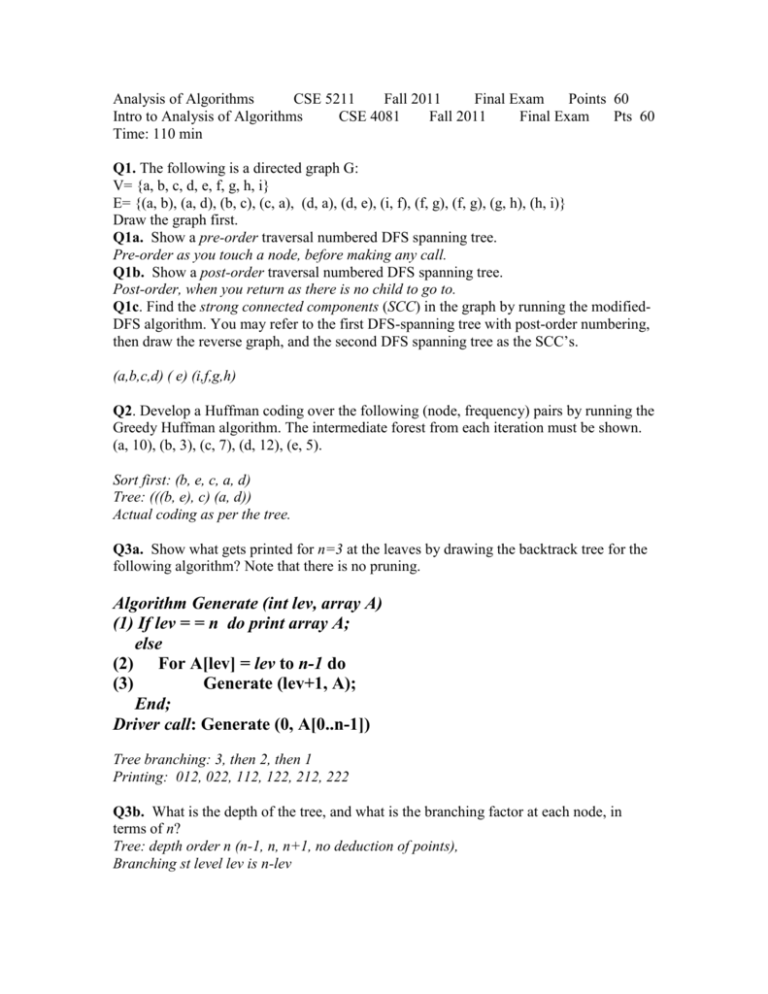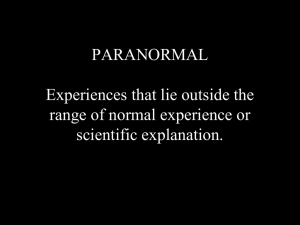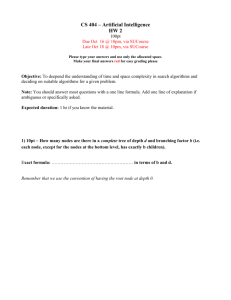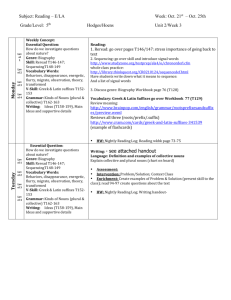Algorithms
advertisement

Analysis of Algorithms
CSE 5211
Fall 2011
Final Exam
Points 60
Intro to Analysis of Algorithms
CSE 4081
Fall 2011
Final Exam
Pts 60
Time: 110 min
Q1. The following is a directed graph G:
V= {a, b, c, d, e, f, g, h, i}
E= {(a, b), (a, d), (b, c), (c, a), (d, a), (d, e), (i, f), (f, g), (f, g), (g, h), (h, i)}
Draw the graph first.
Q1a. Show a pre-order traversal numbered DFS spanning tree.
Pre-order as you touch a node, before making any call.
Q1b. Show a post-order traversal numbered DFS spanning tree.
Post-order, when you return as there is no child to go to.
Q1c. Find the strong connected components (SCC) in the graph by running the modifiedDFS algorithm. You may refer to the first DFS-spanning tree with post-order numbering,
then draw the reverse graph, and the second DFS spanning tree as the SCC’s.
(a,b,c,d) ( e) (i,f,g,h)
Q2. Develop a Huffman coding over the following (node, frequency) pairs by running the
Greedy Huffman algorithm. The intermediate forest from each iteration must be shown.
(a, 10), (b, 3), (c, 7), (d, 12), (e, 5).
Sort first: (b, e, c, a, d)
Tree: (((b, e), c) (a, d))
Actual coding as per the tree.
Q3a. Show what gets printed for n=3 at the leaves by drawing the backtrack tree for the
following algorithm? Note that there is no pruning.
Algorithm Generate (int lev, array A)
(1) If lev = = n do print array A;
else
(2) For A[lev] = lev to n-1 do
(3)
Generate (lev+1, A);
End;
Driver call: Generate (0, A[0..n-1])
Tree branching: 3, then 2, then 1
Printing: 012, 022, 112, 122, 212, 222
Q3b. What is the depth of the tree, and what is the branching factor at each node, in
terms of n?
Tree: depth order n (n-1, n, n+1, no deduction of points),
Branching st level lev is n-lev
Q3c. What is the time-complexity of the algorithm? A line or two discussion is needed
here.
O(n!) or O(N^n)
Q3d. If the steps 2-3 are replaced as follows - discuss briefly what is the timecomplexity of the new algorithm?
(2)
(3)
For A[lev] = 0 to 1 do
Generate (lev+1, A);
O(2^n)
Q4. Solve the following Linear Programming problem by running the Simplex algorithm.
You may stop after completing 3 pivoting iterations.
Maximize
Subject to:
3x1 – x2 - 2x3
x1 + 2x2 + 3x3 28
2x1 + x2 + 5x3 56
4x1 + x2 + 3x3 16
x 1 , x2 , x 3 0
One pivoting gets the answer, max z = 12, at ((4, 0, 0)
Q5. Transform the following SAT problem to a 3SAT problem instance.
What is your number of steps in running the algorithm?
V={a, b, c, d, e, f}; C={(a. ~b, c), (~d), (~c, ~f), (a, b, d, ~e)}
Almost everybody got it. Steps = New+old variables + total clauses = ~19
Q6a. Discuss on the worst case time-complexity of your algorithm in the project (UG:
GameSearch).
O(n logn) ; b^n for b board positions/branching factor, n ply, pruning does not affect
worst-case complexity
Q6b. What can you say about the minimum and maximum space requirements of any
algorithm with O(n^2) time-complexity?
O(1) can be written in each step, so, O(n^2) steps can take O(n^2) maximum space,
minimum space requirement is anything below that – for some footprint of the data
structures O(1)
Q6c. Discuss very briefly if Linear programming problem is NP-hard or not.
Interior-point algorithms are polynomial – LP is not NP-hard, it is in P-class.
Q6d. The problem of finding shortest path between every pair of nodes on a directed
graph is NP-hard problem or not? Discuss very briefly.
Floyd-Warshall is O(n^3) – all-pairs-shortest-path is in P-class
Grad Q6e. For polynomial size n=32, what is the maximum number of threads for the
iterative-FFT that can run in parallel?
O(n/2) or 16 in this case
UG Q6e. In your game search program, how the time will increase if your ply is
increased from 10 to 11 - discuss briefly.
Increases b-times, for b branching factor











